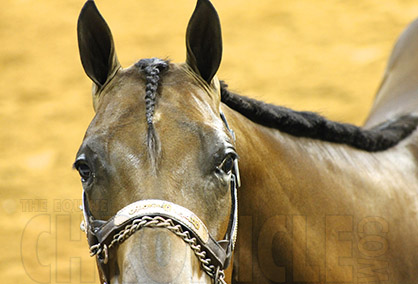Licking and Chewing- A Sign of Submission or Stress?
 International Society For Equitation Science
International Society For Equitation Science
Horses sometimes lick and chew during training and this has often been interpreted as a sign that the horse is learning or showing “submission” to the trainer. However, a new study suggests that this non-nutritive licking and chewing behavior is a natural behavior that is shown after a stressful situation.
To gain insight into the function of licking and non-nutritive chewing behaviour in horses, a team of equine scientists from the Norwegian University of Life Sciences observed the social behavior of feral horses under natural conditions.
M.Sc. Margrete Lie and Prof. Ruth Newberry spent 80 hours observing feral horse herds in Ecuador and collected data on 202 sequences of behavior when licking and chewing behavior occurred. Margrete Lie presented her findings at the 14th International Society of Equitation Science (ISES) conference in Rome last week.
The team wanted to investigate whether non-nutritive chewing was performed to signal submission to another horse and also to study whether horses performed the behavior in between stressed and calm situations.
To find out whether non-nutritive chewing was performed to signal submission, the researchers tested the idea that when one horse (the aggressor) approached another horse (the recipient) in a threatening manner, the recipient but not the aggressor would perform the behavior. The team observed and recorded different behavioral sequences that involved aggressive interactions (for example if one horse herded or threatened another) and recorded whether the chewing behavior was performed by either horse.
The results were fascinating: the team found that the chewing behavior was performed by both the approaching and the recipient horses. Non-nutritive chewing was actually performed more often by the aggressor than the recipient, refuting the assumption this behavior is a submissive signal.
The researchers also investigated whether non-nutritive chewing occurred between tense and relaxed situations. When observing the horses’ behavioral sequences, they found that the majority of the behaviors before chewing were tense and the majority of behaviors after chewing were relaxed. The chewing behaviour occurred when the horses transitioned from a tense to a relaxed state.
The researchers concluded that chewing could be associated with a switch from a dry mouth caused by stress (sympathetic arousal) to salivation associated with relaxation (parasympathetic activity).
The results of this study suggest that non-nutritive chewing was not used as a submissive signal by horses in the contexts observed, but it occurred after a tense situation, likely as a response to a dry mouth.
The research team acknowledge that further research is required to measure the stress responses associated with non-nutritive chewing. However, this study does highlight that licking and chewing likely occurs after a stressful situation and may be used as a behavioral indicator that the previous situation was perceived as stressful by the horse.
To view the ISES position statement on the use/misuse of leadership and dominance concepts in horse training please visit:
https://equitationscience.com/equitation/position-statement-on-the-use-misuse-of-leadership-and-dominance-concepts-in-horse-training).
From researcher Margrete Lie:
“We looked at feral horses living with as little human interference as possible to see how they behaved in their natural habitat. It was important to look at completely natural behavior, and therefore we wanted to see horses living without restriction. These horses were living in a 334 km2 national park, and in the area we observed there were a little under 200 horses. No stallions had been removed from the population as is so common in domestic horses.”
“It was interesting to see how often the horses performed the chewing behavior and also how clear it was that all individuals did chew – not only ‘submissive’ individuals.”
“The study showed that the horses were chewing between calm and relaxed situations, but it does not say if chewing comes as a response to relaxing or if chewing helps them relax. To able to look at this more closely I believe a more controlled study with stress measurements is needed.”
More information:
Keep up to date with the all the latest news from the conference on social media by following #ISESROME2018
Save the date of August 19-21 for the 2019 ISES Conference being held in Guelph, Ontario, Canada. The theme of “Bringing science to the stable” will explore our relationship with horses through the past, present and future. Check the ISES website for conference updates https://equitationscience.com/conferences/.
To stay informed about the International Society of Equitation Science, sign up for our email news at www.equitationscience.com and like the ISES Facebook page for updates. If you are a current ISES member, you can also request to join the discussions on the closed Facebook group, ISES Members Forum.
Researchers: M. Lie1,2* and R.C. Newberry1
1. Department of Animal and Aquacultural Sciences, Norwegian University of Life Sciences, Norwegian University of Life Sciences, P.O. Box 5003, NO-1432 Ås, Norway
2. Hesteglede, Ås, Norway
Email Margret Lie: *lmargrete@gmail.com










